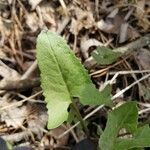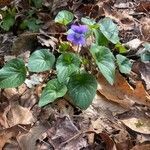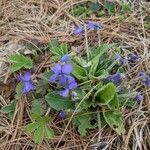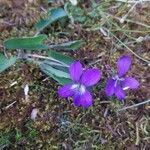Plants perennial, acaulescent, not stoloniferous, 5–50 cm; rhizome thick, fleshy. Leaves basal, 4–8, ascending to erect; stipules linear-lanceolate, margins entire, apex acute; petiole 2–13 cm, glabrous or pubescent; middle and lateral blade lobes differ in width and/or shape, earliest blades ovate to elliptic, mid-season blades ovate, elliptic, narrowly elliptic to narrowly deltate, 1–8 × 1–5 cm, incised or lobed at base only, base sagittate or hastate, truncate, attenuate, or ± cordate, margins crenate or serrate, ciliate or eciliate, apex acute, surfaces glabrous or pubescent. Peduncles 3–15 cm, glabrous or pubescent. Flowers: sepals lanceolate to ovate, margins ciliate or eciliate, auricles 2–3 mm; petals light to dark violet on both surfaces, lower 3 white basally, lowest dark violet-veined, lateral 2 densely bearded, spur on lowest petal occasionally bearded, lowest 10–15 mm, spur light to dark violet, gibbous, 2–3 mm; style head beardless; cleistogamous flowers on prostrate, ascending, or erect peduncles. Capsules ellipsoid, 10–14 mm, glabrous. Seeds beige, mottled to bronze, 1.3–2.5 mm.
More
Acaulescent, glabrous or hairy; principal lvs relatively narrow, mostly ovate or narrower, generally at least 1.5 times as long as wide, subtruncate to shallowly cordate at base, sometimes all merely crenate-serrate, sometimes some of them with notably larger and more spreading teeth at the base or with small basal lobes; fls 2–2.5 cm wide, violet-purple, the 3 lower pet bearded at base; style, as in the following 5 spp., dilated upwards in a vertical plane, capitate, with a conic beak on the lower side, the stigma within the tip of the beak; cleistogamous fls on erect or ascending peduncles; fr ovoid; seeds brown; 2n=54. Dry to moist, open woods, clearings, and meadows, less often along streams, often in drier, sunnier habitats than no. 5 [Viola sororia Willd.]; Me. and N.S. to Minn., s. to Fla. and La. Apr.–June. (V. fimbriatula; V. emarginata, the name applied to apparent hybrids with other stemless blue spp.)






